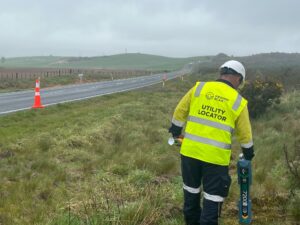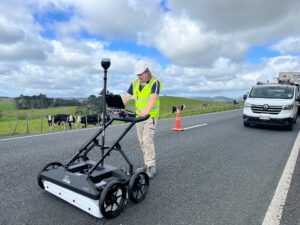Locating underground high-voltage (HV) power cables is a crucial part of any excavation, construction, or infrastructure development project. Accurate cable detection helps prevent damage, service interruptions, costly repairs, and serious safety hazards.

Many professionals rely on Electromagnetic Location (EML) equipment as part of standard underground service locating practices. However, when it comes to high-voltage cable detection, EML can be unreliable on its own due to the way these cables are engineered and how electromagnetic fields behave underground.
In New Zealand and globally, asset owners, contractors, and surveyors increasingly recognise that HV networks require more advanced detection techniques. The combination of shielding, current balancing, and environmental interference often makes high-voltage cables difficult—or sometimes impossible—to locate accurately with EML alone. Understanding these limitations is essential for anyone involved in utility locating services, cable avoidance, or subsurface mapping to ensure safe and efficient operations.
Several factors contribute to the difficulty of using EML to locate HV cables:
• Shielding:
Many HV cables—especially those designed for reliability and safety—are built with metallic shielding or concentric neutral conductors around the internal cores. This shielding is intended to contain the cable’s own electromagnetic emissions and prevent external interference. While beneficial for system performance, it significantly weakens the external electromagnetic field, making the cable difficult for an EML receiver to detect.
• Balanced Currents:
In a well-designed power system, electrical currents within the conductors are balanced between phases and neutral. This balance causes the resulting magnetic fields to cancel out, producing a very faint external field. As a result, passive EML systems often struggle to detect these cables, since the remaining electromagnetic signal is extremely weak.
• Electromagnetic Noise and Distortion:
High voltage lines can generate substantial electromagnetic noise, even with shielding in place. This interference can overlap with or distort the signals that EML devices rely on, making it difficult to distinguish the target cable’s signal from other nearby metallic objects or utilities, such as rebar, fences, or manhole covers.
• Signal Coupling and Bleed-Over:
In areas dense with underground infrastructure, the signal from an EML transmitter can unintentionally transfer—or “couple”—onto nearby metallic objects or utilities. This occurs when an adjacent structure provides a more conductive path to ground, potentially resulting in incorrect signal tracing and cable misidentification.
• Depth and Signal Loss:
As cable depth increases, the strength of the detectable electromagnetic signal at the surface decreases. Soil type and moisture content can further reduce signal transmission, particularly in dry or rocky conditions. Additionally, the high-voltage environment itself can influence how the signal travels, further complicating detection efforts.
• Passive Detection Limitations:
While EML locators can sometimes identify energized cables in passive mode by detecting their 50/60 Hz current, this approach is unreliable for confirming identity or measuring depth. It can also generate false positives. Active methods—where a specific frequency is applied to the line—can improve accuracy but remain subject to the interference, coupling, and attenuation challenges described above.
 Because of these issues, relying solely on EML for HV cable detection can lead to inaccurate or misleading results. The most effective approach is to combine several complementary locating methods, such as Ground Penetrating Radar (GPR), advanced mapping tools, and expert data interpretation. Using multiple technologies allows for cross-verification of results and a clearer understanding of subsurface conditions—particularly in areas with dense utility networks or complex soil environments.
Because of these issues, relying solely on EML for HV cable detection can lead to inaccurate or misleading results. The most effective approach is to combine several complementary locating methods, such as Ground Penetrating Radar (GPR), advanced mapping tools, and expert data interpretation. Using multiple technologies allows for cross-verification of results and a clearer understanding of subsurface conditions—particularly in areas with dense utility networks or complex soil environments.
In New Zealand, Ground Scan NZ specialises in this integrated approach to underground utility detection. Their experienced team combines EML, GPR, and other advanced surveying technologies to provide precise, reliable, and safe high-voltage cable location services. By applying expert analysis and field experience, Ground Scan NZ helps clients reduce the risk of costly utility strikes, prevent service disruptions, and maintain compliance with safety regulations—ensuring that every project proceeds smoothly and efficiently.


